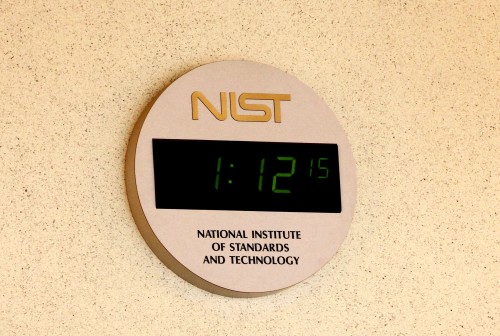
Keepers of time: at the NIST campus in Gaithersburg. (Courtesy: Tushna Commissariat)
By Tushna Commissariat in New York City, US
As most of our regular blog readers will know, last week Physics World‘s Matin Durrani and I were in Baltimore attending the APS March meeting. While we spent most of the week at the conference centre, last Friday we visited the National Institute of Standards and Technology’s (NIST) Gaithersburg campus, as well as the Joint Quantum Institute (JQI), which is based at the University of Maryland. It was a jam-packed, exciting day that we spent zipping around to and from more than 10 different labs and departments, meeting people who use physics to do everything from improve the safety of body armour to redefining the kilogram.
As we saw so many interesting projects, covering them all would make for a rather long read. Instead, join me for a quick visual tour of NIST below (I will cover our JQI visit in a separate blog) to get a small taste of the physics and people involved.
Arriving at the main NIST building, it was easy to spot the slightly vintage look of the lab. We began our tour with lunch at the canteen, which was wonderfully described by NIST’s media officer Chad Boutin as “Kennedy kitsch” – a nice example of this were the digital clocks (you can see one above) dotted along its walls.
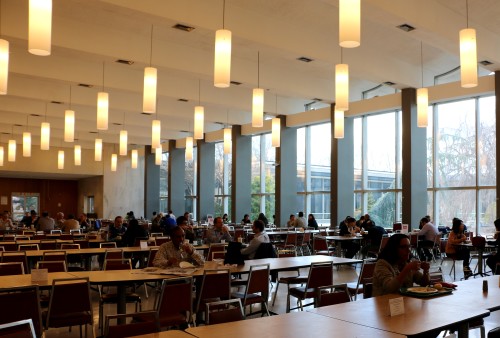
A fifties look: lunchtime at the NIST canteen. (Courtesy: Tushna Commissariat)
Post lunch, our first stop was at the Material Measurement Laboratory (MML), where we met with the Security Technologies Group (STG). Among the many standards that NIST sets, the STG helps the government to determine the performance-based standards for technologies used by law enforcement, such as those for protective vests.
The image below shows where the group tests the strength of different types of “ballistic-resistant body armour”. The set-up you can see beyond the glass includes a modified “gun” that is fired via a switch in the next room, a set of infrared scanners that determine the bullet’s speed, and the vest attached to a large block of modelling clay that deforms much like a human body would upon impact.
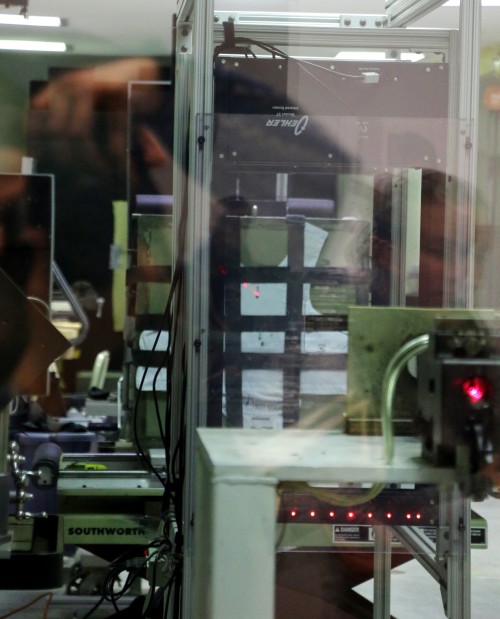
Laser precision: the Security Technologies Group’s ballistic-resistant body-armour testing facility. (Courtesy: Tushna Commissariat)
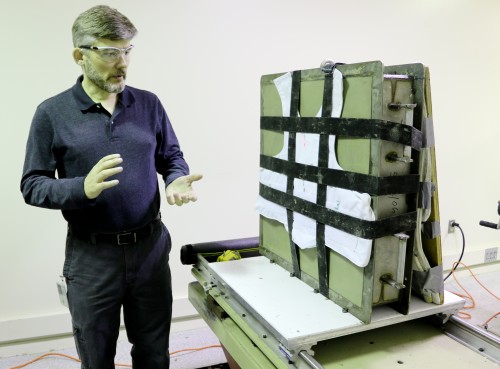
In place: MML’s Michael Riley talks about the clay target that a vest is strapped onto. (Courtesy: Tushna Commissariat)
I had the chance to “shoot” the gun (I simply flipped the switch) and the bullet actually penetrated the armour, as you can see below. The shot was set up right on the edge of one of the main plates in the vest and it tore through, gouging out a hole in the clay. The STG group also studies a variety of other things, from stab-resistant materials to object detection.

Lock, stock and no smoking barrel: the dent that my shot made into the clay. (Courtesy: Tushna Commissariat)
Our next stop was with the MML’s Surface and Trace Chemical Analysis Group, headed up by Greg Gillen. This was a rather fascinating lab where the researchers develop various methods with which they can trace and detect contraband substances in public places such as airports, without it being highly disruptive. The team has adopted a variety of techniques – everything from vapour-sampling to biomimicry to mass spectroscopy – to detect banned substances.
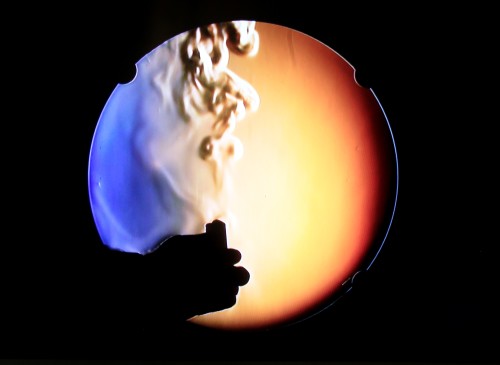
Vapour fog: a lighter’s fumes seen in the vapour-sampling method. (Courtesy: Tushna Commissariat)
Next, we switched tracks slightly and moved on to NIST’s Physical Measurement Laboratory to meet Jay Hendricks and learn about how pressure is currently determined via a manometer that uses the pressure of a tall column of mercury vapour and how he hopes to switch to his newly developed photonic pressure standard, for which a prototype has already been built.
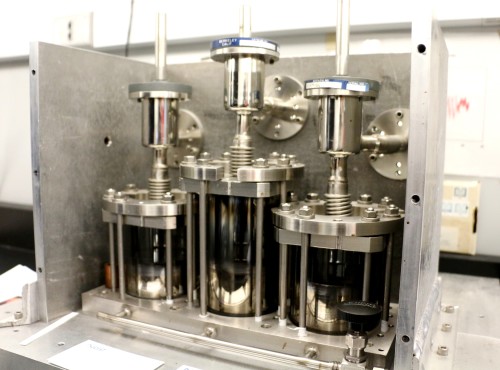
Under pressure: mercury gauges have been the pressure standard for over 400 years. (Courtesy: Tushna Commissariat)
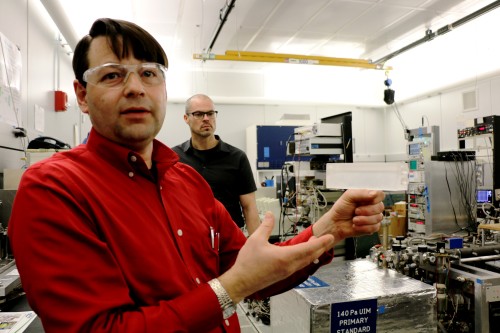
Light pressure: Jay Hendricks displaying a prototype photonic manometer. (Courtesy: Tushna Commissariat)
The next lab we went to was deep underground, located in the room with high ceilings that seemed to be made entirely of metal and filled with wheels and cogs and a pulley system that was large enough to be a small crane. This fully shielded and environmentally controlled room houses NIST’s watt balance – a device used to determine mass using fundamental constants as it compares electrical and mechanical power. This is one of the main methods scientists are looking at to help redefine the kilogram in the next few years. (More on this and other methods in the Physics World feature “Metrology in the balance”.) We had a great time learning more about NIST-4 watt balance from lead researcher Stephan Schlamminger, who we also filmed so keep an eye out for a video or two soon.
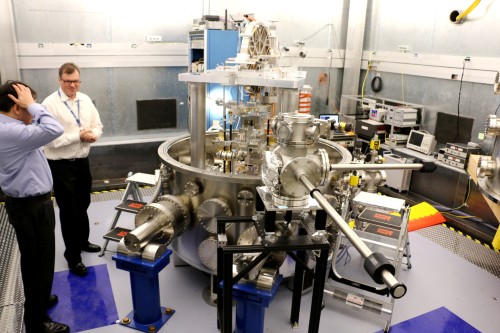
Watt’s up: Matin Durrani (left) and Stephan Schlamminger take a look at NIST-4. (Courtesy: Tushna Commissariat)
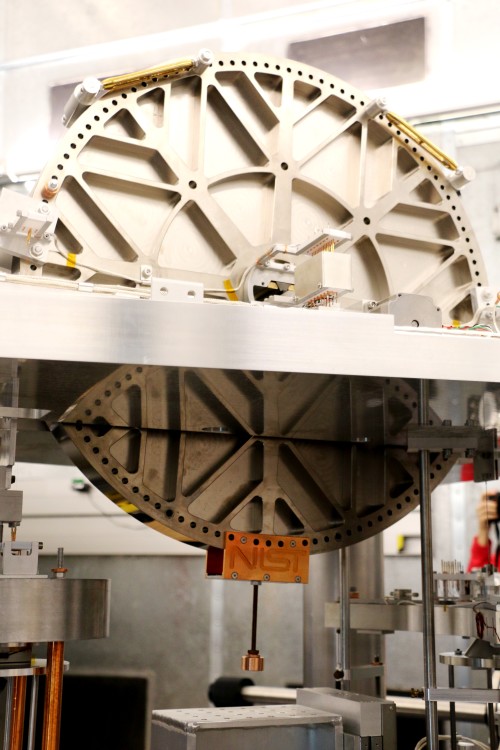
Hefty spin: a close-up of the balance wheel. (Courtesy: Tushna Commissariat)
Our last and final stop for the day was at the NIST Center for Neutron Research (NCNR), the leading neutron-source facility in the US. Neutrons are important imaging particles as they reveal certain properties that cannot be probed by electrons, light or X-rays. The centre facilitates up to 28 experiments at any given time and many of the beamlines were up and running while we were visiting. There, we met with Daniel Hussey, who has been developing a “neutron microscope“.
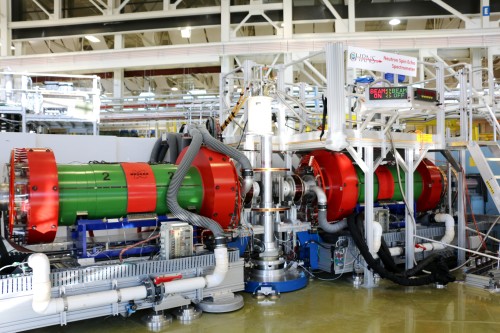
Beaming away: one of the experiments on the NCNR beamline (Courtesy: Tushna Commissariat)
That was the end of our long and enjoyable day at NIST and it’s also the end of our photowalk – keep an eye out for more videos and blogs from our trip.
Good idea to visite the NIST, where apart from the setting up and improving the “Watt balance”, the work on the “Photonic pressure standard” is really worthwhile knowing that for dry air at normal temperature, the refractive increases only by about 1. 10^-6 per pascal of pressure.
Trackback: Blog - physicsworld.com